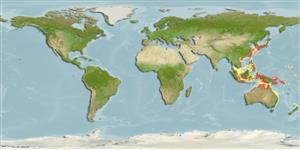>
Ovalentaria/misc (Various families in series Ovalentaria) >
Pomacentridae (Damselfishes) > Chrominae
Etymology: Chromis: Greek, chromis = a fish, perhaps a perch (Ref. 45335); albicauda: Name from Latin meaning 'white tail' for its diagnostic feature that separates this species from Chromis analis..
Environment: milieu / climate zone / depth range / distribution range
Ecologie
marien rifbewoner; diepte 25 - 70 m (Ref. 90102), usually ? - 30 m (Ref. 82433). Tropical
Western Pacific: Indonesia and southern Japanese seas; distribution probably disjunct due to association with cool temperature regimes.
Grootte / Gewicht / Leeftijd
Maturity: Lm ? range ? - ? cm
Max length : 13.4 cm SL mannelijk / geslacht onbekend; (Ref. 82433)
Korte beschrijving
Determinatiesleutels | Morfologie | Morfometrie
Dorsale stekels (totaal) : 13; Dorsale zachte stralen (totaal) : 11 - 12; Anale stekels: 2; Anale zachte stralen: 11 - 12. This species is distinguished by the following characters: D XIII,12 (rarely 11); A II,12 (rarely 11); pectoral rays 18-20; spiniform caudal rays 3; tubed lateral-line scales 17-19; gill rakers 7-8 + 24-26, total rakers 24-26; body depth 1.8-1.9 in SL; edge of suborbital hidden by scales; 4-5 scale rows on anterior portion of preorbital; generally yellow in life, grading to brown on upper back with abruptly white caudal fin; blackish anal opening which is also evident in preserved specimens (Ref. 82433).
Adults are commonly observed in areas of cool (18°-24°C) upwelling along the northern and western shores of Nusa Penida at about 25-50 m. They typically form aggregations, which feed high in the water column on zooplankton when currents are strong (Ref. 82433). Oviparous, distinct pairing during breeding (Ref. 205). Eggs are demersal and adhere to the substrate (Ref. 205). Males guard and aerate the eggs (Ref. 205).
Levenscyclus en paargedrag
Maturities | Voortplanting | Spawnings | Egg(s) | Fecundities | Larven
Oviparous, distinct pairing during breeding (Ref. 205). Eggs are demersal and adhere to the substrate (Ref. 205). Males guard and aerate the eggs (Ref. 205).
Allen, G.R. and M.V. Erdmann, 2009. Two new species of damselfishes (Pomacentridae: Chromis) from Indonesia. aqua, Int. J. Ichthyol. 15(3):121-134. (Ref. 82433)
Status op de Rode Lijst van het IUCN (Ref. 130435)
Gevaar voor de mens
Harmless
Gebruik door de mens
Tools
Speciale rapporten
Download XML
Internetbronnen
Estimates based on models
Fylogenetische diversiteitsindex (Ref.
82804): PD
50 = 0.5000 [Uniqueness, from 0.5 = low to 2.0 = high].
Bayesian length-weight: a=0.01778 (0.00796 - 0.03971), b=2.99 (2.81 - 3.17), in cm total length, based on LWR estimates for this Genus-body shape (Ref.
93245).
Trofisch niveau (Ref.
69278): 3.0 ±0.1 se; based on size and trophs of closest relatives
Weerstandsvermogen (Ref.
120179): Gemiddeld, minimale populatieverdubbelingstijd 1,4-4,4 jaar (Preliminary K or Fecundity.).
Fishing Vulnerability (Ref.
59153): Low vulnerability (10 of 100).
